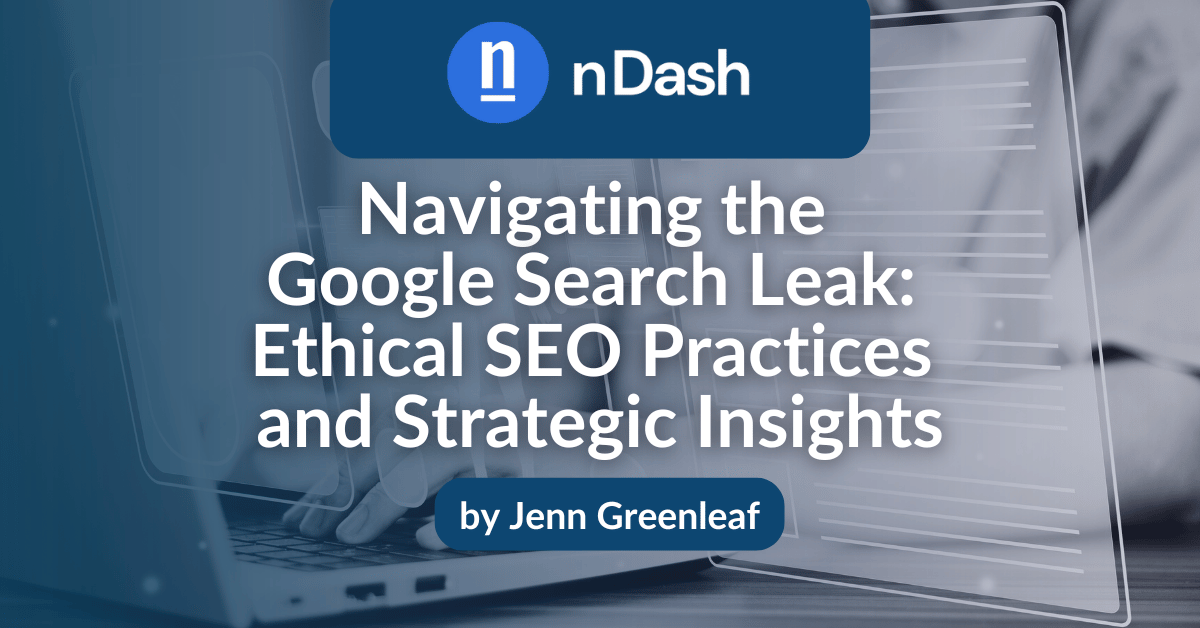A recent leak of 2,500 pages of internal Google documentation has provided accidental insights into how Google Search operates. These documents confirm intricate details about algorithms, policies, and strategic decisions shaping search results and influencing web content.
About the Google Search Leak
In May 2024, 2,500 pages of internal Google documentation leaked, providing SEO strategists and content marketing managers with an unparalleled opportunity to understand the inner workings of Google’s search algorithms. The first report of the Google search leak emerged on May 27, 2024, creating a buzz across the SEO community.
These documents reveal detailed insights into the factors that influence search rankings, from traditional elements like keyword relevance and backlink quality to advanced techniques such as entity recognition and user intent modeling. Understanding these factors is essential for refining SEO strategies and improving search visibility.
However, this leak also brings ethical considerations to the forefront. How should SEO professionals use this information responsibly? How can they balance the benefits of these insights with the need to maintain transparency and trust?
This guide explores the key revelations from the Google search leak and their implications for SEO and content marketing. We provide actionable strategies to enhance your SEO efforts, focusing on ethical practices that prioritize user experience and content quality. You’ll learn about the importance of E-A-T (Expertise, Authoritativeness, Trustworthiness), the role of user data in personalization, and how to navigate the dynamic relationship between paid and organic search.
Key Insights From the Google Search Leak
There’s a brief talk track about the Google Search Leak by Rand Fishkin in the following tweet:
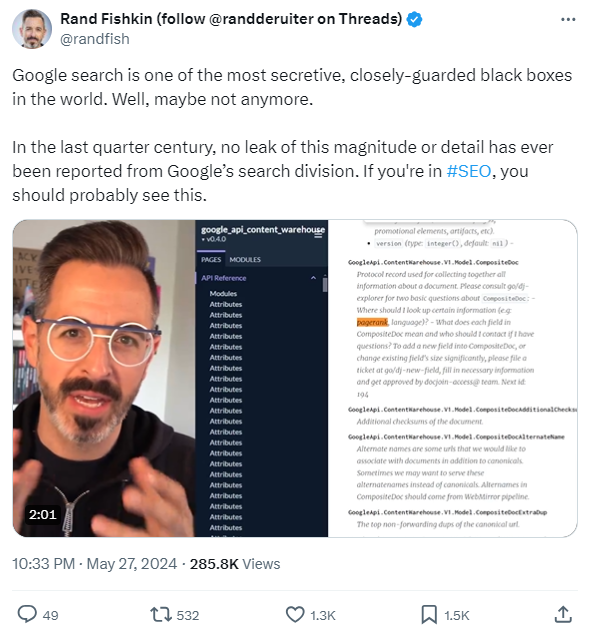
Google search is one of the most secretive, closely-guarded black boxes in the world. Well, maybe not anymore.
In the last quarter century, no leak of this magnitude or detail has ever been reported from Google’s search division. If you’re in #SEO, you should probably see this. pic.twitter.com/JxEs55IV21
— Rand Fishkin (follow @randderuiter on Threads) (@randfish) May 28, 2024
Algorithm Prioritization and Ranking Factors
The leaked documents highlight Google’s complex ranking system, which covers both traditional and advanced factors that influence search results. Understanding these elements is crucial for SEO strategists and content marketers aiming to optimize their strategies effectively.
Traditional Ranking Factors
Google’s algorithms prioritize several well-known factors to rank search results, including:
- Keyword relevance: The presence and placement of keywords within content, title tags, and meta descriptions significantly impact rankings. Content that aligns closely with the search query tends to perform better.
- Backlink quality: The number and quality of backlinks from reputable sites signal to Google that a webpage is authoritative and trustworthy. High-quality backlinks improve a site’s credibility and search visibility.
- Content freshness: Regularly updated content is favored, as it is more likely to be relevant and accurate. Fresh content can boost rankings, especially for time-sensitive queries.
- Page load speed: Faster-loading pages provide a better user experience and are preferred by Google. Optimizing load times can improve search rankings.
- Mobile-friendliness: Over half of web traffic comes from mobile devices. If a website isn’t mobile-friendly, it creates a poor user experience for the majority of visitors. Google prioritizes mobile-optimized content in its rankings.
Advanced Elements: Entity Recognition and User Intent Modeling
In addition to traditional factors, Google employs sophisticated techniques to refine search results further:
Entity Recognition
The leaked documents reveal that Google’s algorithms increasingly rely on entity recognition to understand and categorize content.
Implications:
- Content structuring: Use structured data markup (Schema.org) to help search engines identify and understand entities within your content.
- Comprehensive coverage: Ensure your content provides thorough information on identified entities, linking to authoritative sources for additional context.
💡 Action items:
- Implement structured data markup to highlight key entities within your content.
- Create detailed content that covers various aspects of the identified entities, ensuring a holistic approach.
User Intent Modeling
- Definition: User intent modeling involves predicting and understanding what users are looking to achieve with their search queries. This goes beyond matching keywords to considering the context and expected outcome of the search.
- Impact: By modeling user intent, Google delivers results that better fulfill the user’s needs, whether informational, navigational, or transactional.
- Example: A search for “best running shoes” likely indicates an intent to purchase, prompting Google to display product reviews, comparisons, and links to online stores rather than just informational articles about running shoes.
These advanced elements, combined with traditional ranking factors, illustrate the depth and sophistication of Google’s algorithms. As Danny Sullivan, Google’s Search Liaison, emphasizes, “Google’s long-standing advice of ‘Don’t do things for Google’ is counter-intuitive to anyone who is trying to be successful with Google. It’s about understanding what the user truly wants.”

The Google Search Leak and The Potential Impact of Bad Backlinks
The Google Search leak presents insights into the detrimental effects of bad backlinks on search rankings, suggesting that their impact may be greater than previously assumed. This is likely to have substantial implications for SEO practices, particularly for those relying on link schemes.
Understanding Bad Backlinks
Bad backlinks are links from low-quality, spammy, or irrelevant websites. These links can harm a site’s search rankings by signaling to Google that the site is attempting to manipulate search results through unnatural linking practices.
Key characteristics of bad backlinks:
- Low authority: Links from sites with low domain authority and poor reputation.
- Irrelevance: Links from sites that are not relevant to your industry or content.
- Spammy nature: Links from sites that appear to be part of link farms or have a history of engaging in spammy practices.
- Over-optimized anchor text: Links with anchor text that is overly optimized for specific keywords, indicating manipulative practices.
The Downfall of Link Schemes
Link schemes, which promote themselves as beneficial for SEO by offering large quantities of backlinks, are particularly affected by this revelation. Their practices often involve generating low-quality, irrelevant links, which are now more likely to trigger penalties from Google.
Negative Outcomes for Link Schemes:
- Reputation damage: As the effectiveness of their services is called into question, link schemes are likely to see a decline in demand and client trust.
- Client penalties: Websites that have used these services may experience significant drops in rankings, leading to potential loss of traffic and revenue.
- Shift in SEO strategies: SEO professionals and businesses will need to pivot away from reliance on link schemes and focus on acquiring high-quality, relevant backlinks.
Actionable Steps for SEO Professionals
Given the increased impact of bad backlinks, it is crucial for SEO professionals to adopt strategies that prioritize link quality over quantity. Here are some actionable steps:
Audit Your Backlink Profile
- Regularly review your site’s backlink profile using tools like Ahrefs, SEMrush, or Google Search Console.
- Identify and disavow bad backlinks to prevent them from negatively impacting your rankings.
Focus on Quality Link-Building
- Seek backlinks from high-authority, relevant websites within your industry.
- Build relationships with reputable sites and industry influencers to earn valuable backlinks organically.
Avoid Manipulative Practices
- Steer clear of link schemes and any services that promise large quantities of backlinks for a low price.
- Ensure your link-building strategies comply with Google’s guidelines to avoid penalties.
Enhance Content Quality
- Create high-quality, valuable content that naturally attracts backlinks from authoritative sources.
- Engage in content marketing practices such as guest blogging, contributing to reputable publications, and participating in industry forums.
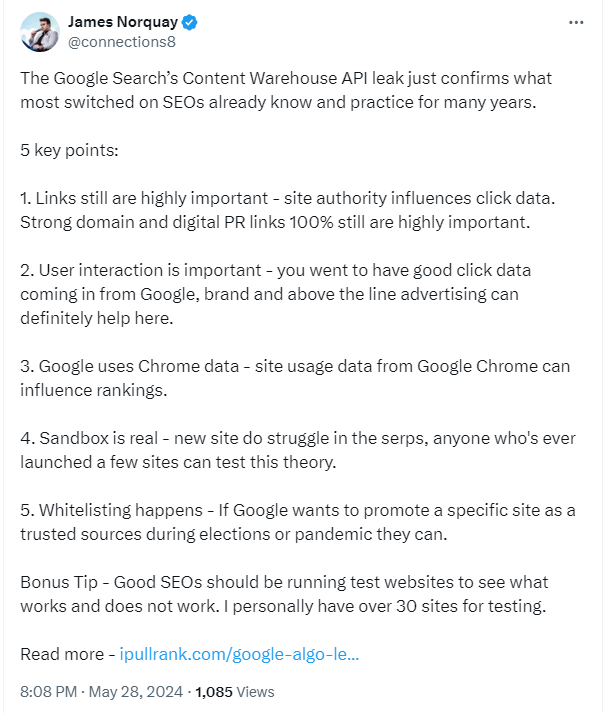
Search Quality Evaluator Guidelines
A key aspect of these guidelines is the E-A-T framework. Understanding and implementing E-A-T principles is crucial for brands looking to improve their search rankings.
The E-A-T Framework
To establish E-A-T, brands can take several actionable steps:
1. Expertise
- Create High-Quality, Expert-Driven Content:
Ensure that content is produced or reviewed by subject matter experts. For instance, a health website should feature articles written by licensed medical professionals.
Example: A financial advice blog could include articles written by certified financial planners with detailed insights and practical advice. - Showcase Author Credentials:
Highlight the credentials of content creators on your website. This can include degrees, certifications, and relevant work experience.
Example: A technology blog could provide author bios that list the writers’ degrees in computer science and their years of industry experience.
2. Authoritativeness
- Build a Strong Online Presence:
Gain recognition in your industry by contributing to reputable websites, participating in industry forums, and earning mentions from other authoritative sites.
Example: A legal advice website might contribute guest posts to respected legal publications and be cited by other legal experts. - Obtain High-Quality Backlinks:
Seek backlinks from reputable and relevant websites to boost your site’s authority.
Example: An e-commerce site selling eco-friendly products could get backlinks from environmental organizations and sustainability blogs.
3. Trustworthiness
- Provide Transparent and Accurate Information:
Ensure all content is fact-checked, well-researched, and regularly updated. Clearly state the sources of your information and provide references where applicable.
Example: A news website could link to original sources and include citations for statistics and quotes. - Maintain a Secure Website:
Enable secure communication channels using SSL certificates to safeguard sensitive user information. Display trust signals, like badges for secure payments and privacy policies.
Example: To build customer trust, an online retailer should display security seals, have a clear privacy policy, and use secure payment gateways.
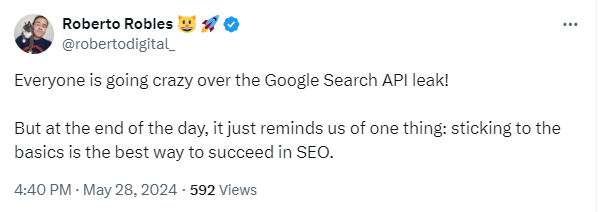
Practical Implementation
Lily Ray, an SEO Director at Path Interactive, explains, “E-A-T has become crucial in how Google evaluates content quality. Brands and authors must establish their authority and trustworthiness to rank well.”
Here are some practical examples of how brands can establish these qualities:
Health and Wellness Blog
- Expertise: Feature articles written by licensed nutritionists and fitness experts.
- Authoritativeness: Get backlinks from well-known health websites and participate in health industry webinars.
- Trustworthiness: Provide detailed author bios, cite medical studies, and ensure the website is HIPAA-compliant.
Financial Advice Platform
- Expertise: Publish content by expert finance writers, certified financial advisors, and accountants.
- Authoritativeness: Contribute to major financial publications and earn mentions from authoritative financial blogs.
- Trustworthiness: Display credentials, cite authoritative sources, and use secure data handling practices.
Travel Website
- Expertise: Include travel guides written by seasoned travel writers and destination experts.
- Authoritativeness: Obtain backlinks from renowned travel magazines and tourism boards.
- Trustworthiness: Provide accurate, up-to-date travel information, user reviews, and secure booking options.
Blacklists and Penalties
The Google search leak shed light on Google’s rigorous efforts to maintain search quality and combat spam through both manual actions and algorithmic penalties. These measures target practices such as:
- Cloaking: Showing different content to users than to search engines to manipulate rankings.
- Sneaky redirects: Redirecting users to different pages than those shown to search engines.
- Keyword stuffing: Overloading a webpage with keywords to manipulate its search ranking.
- Link schemes: Engaging in unnatural linking practices to manipulate rankings.
These practices are detrimental to user experience and undermine the integrity of search results.
John Mueller, a Google Webmaster Trends Analyst, often discusses the importance of ethical SEO practices. He notes that manipulative techniques may yield short-term gains, but they inevitably lead to penalties. Long-term success is built on transparency and quality.
Practical Implications and Examples
To illustrate the impact of blacklisting and penalties, consider these scenarios:
- A website engaging in keyword stuffing: This site may initially see a spike in search rankings due to the overuse of targeted keywords. However, once Google detects this manipulative behavior, the site will face a ranking penalty, causing a significant drop in search visibility.
- A site using sneaky redirects: Initially, this might divert traffic to more profitable or deceptive pages. But once Google identifies the deceptive practice, the site can be blacklisted, severely damaging its reputation and search ranking.
Personalization and User Data Utilization
Google personalizes search results using various types of user data, including:
- Location: Tailoring results based on the user’s geographical location.
- Search history: Providing results that align with past search behavior.
- Device information: Optimizing results for the device being used, such as mobile or desktop.
These personalization efforts aim to enhance relevance and improve the overall user experience by delivering more precise and contextually appropriate search results.
However, this approach raises significant privacy concerns. However, as Greg Sterling, a Contributing Editor at Search Engine Land, explains, while personalization improves relevance and user experience, it simultaneously raises significant privacy concerns regarding data usage and storage. This balance between personalization benefits and privacy issues is a critical aspect of modern digital marketing strategies.
Implications for SEO and Content Marketing
Understanding the nuances of personalization and user data utilization can help SEO professionals and content marketers better align their strategies:
Enhancing User Experience
Example: A local restaurant optimizing its SEO to appear in search results for users in nearby areas. By leveraging location data, the restaurant can attract local customers more effectively.
💡 Action item: Use local keywords and ensure your Google My Business profile is up-to-date to improve local search visibility.
Tailoring Content to User Preferences
Example: An e-commerce site offering personalized product recommendations based on past user searches and purchases. This increases the likelihood of conversions by presenting users with relevant options.
💡 Action item: Implement personalized content recommendations on your website to cater to individual user interests and behaviors.
Balancing Privacy and Personalization
Example: A website that transparently explains how user data is collected and used and offers options for users to control their privacy settings builds trust and aligns with data protection regulations.
💡Action item: Clearly communicate your data privacy policies and provide users with easy-to-use privacy controls.
Navigating Privacy Regulations
Example: Adhering to regulations such as the General Data Protection Regulation (GDPR) and the California Consumer Privacy Act (CCPA) to ensure compliant data handling practices.
💡 Action item: Regularly review and update your data privacy practices to remain compliant with evolving regulations and to protect user data.
Ad and Organic Search Relationship
Speculation has long surrounded the influence of advertising on organic search results. The leaked documents clarify Google’s strict separation between paid and organic search operations, ensuring that advertising does not directly affect organic rankings. However, high-performing ads can indirectly impact organic rankings by increasing site traffic and user engagement.
Understanding the Dynamic
Rand Fishkin, Founder of SparkToro, emphasizes the importance of understanding this dynamic. He states, “Relying on search engines to reach your customers inherently makes brands susceptible to the way those search engines deliver results. However, by complementing your SEO efforts with a strategy that creates demand for your brand, you may be able to insulate yourself and stay ahead of the competition.”
Practical Implications and Strategies
Indirect Benefits of High-Performing Ads
Example: A successful ad campaign drives a significant influx of traffic to a website, boosting overall engagement metrics such as time on site, page views, and interaction rates. While these metrics primarily benefit from paid efforts, they can enhance the website’s credibility and relevance, positively influencing organic search performance.
💡 Action item: Run targeted ad campaigns to drive high-quality traffic to your site. Ensure the landing pages are optimized for user experience to maximize engagement and conversions.
Creating Demand for Your Brand
Example: By generating interest and demand through advertising, a brand can increase its organic search visibility as more users search for the brand directly or related terms.
💡 Action item: Develop a holistic marketing strategy that includes both SEO and paid advertising. Use ads to build brand awareness and create a demand that supports your organic search efforts.
Integrating SEO and PPC Strategies
Example: Coordinating SEO and PPC campaigns to cover all stages of the buyer’s journey. For instance, using PPC ads to capture immediate intent and SEO to provide comprehensive information and support long-term engagement.
💡 Action item: Align your SEO and PPC strategies to ensure they complement each other. Use insights from PPC campaigns to identify high-converting keywords and topics that can be leveraged in your SEO strategy.
Monitoring and Adjusting Based on Performance
Example: Regularly analyzing the performance of both paid and organic efforts to understand their interplay and make data-driven adjustments.
💡 Action item: Use analytics tools to track the performance of your paid and organic campaigns. Based on insights, adjust your strategies to optimize both channels effectively.
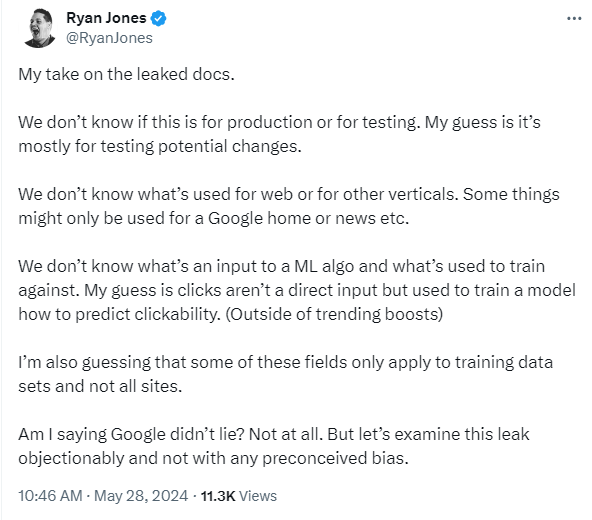
Industry Reactions
The Google search leak has elicited various responses from industry professionals, ranging from concerns about privacy and ethical implications to acknowledgments of the transparency it brings to Google’s operations.
Privacy Concerns
Experts express worries about user data use and potential misuse. The documents reveal the extent to which Google personalizes search results using user data such as location, search history, and device information. While this personalization enhances relevance and user experience, it raises significant privacy concerns regarding data usage and storage.
Algorithm Transparency
SEO professionals appreciate the detailed insights into ranking factors and algorithm updates provided by the leaked documents. These insights help SEO practitioners optimize their websites more effectively, aligning their strategies with the latest understanding of Google’s search algorithms. By knowing more about what factors influence rankings, they can make more informed decisions about content and technical SEO practices.
Ethical Considerations
The exposure of blacklisting and penalty practices has sparked discussions on the ethics of search engine management. The leaked documents detail how Google applies manual actions and algorithmic penalties to maintain search quality and combat spam. This transparency highlights the need for ethical SEO practices, focusing on long-term strategies rather than manipulative techniques.
Barry Schwartz, an SEO expert and News Editor at Search Engine Land, often discusses the importance of adapting to changes and maintaining ethical standards in SEO practices. He emphasizes that while new information from leaks can provide valuable insights and confirm many theories, SEO professionals must focus on ethical practices and high-quality content. Schwartz notes that transparency in Google’s operations should guide SEOs toward more ethical and user-centric approaches.
Practical Implications
Privacy Considerations
Example: SEO professionals must balance the benefits of personalized search results with the ethical implications of data usage.
💡 Action item: Implement robust data privacy measures and be transparent with users about how their data is used.
Leveraging Algorithm Transparency
Example: Use the detailed insights from the Google search leak documents to refine SEO strategies and improve website optimization.
💡 Action item: Regularly update SEO practices based on the latest understanding of Google’s algorithms to stay ahead of competitors.
Ethical SEO Practices
Example: Avoid manipulative techniques that may yield short-term gains but lead to penalties. Focus on building high-quality, valuable content for users.
💡 Action item: Prioritize transparency, authenticity, and user experience in all SEO efforts.
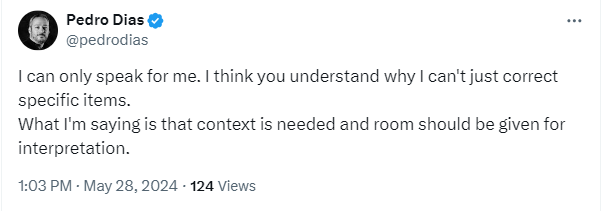
Can We Trust the Google Search Leak?
Determining the trustworthiness of the purported Google search leak involves several factors, including the authenticity of the documents, the credibility of the sources reporting on the leak, and the responses from Google and industry experts.
Authenticity of the Documents
Assessing the authenticity of the leaked documents is crucial. Genuine leaks typically contain verifiable information aligning with known facts or previously confirmed data, such as internal memos, emails, or technical details that can be cross-referenced with existing public information. Additionally, authentic documents often include specific language, formatting, and technical jargon consistent with the organization’s standard communications.
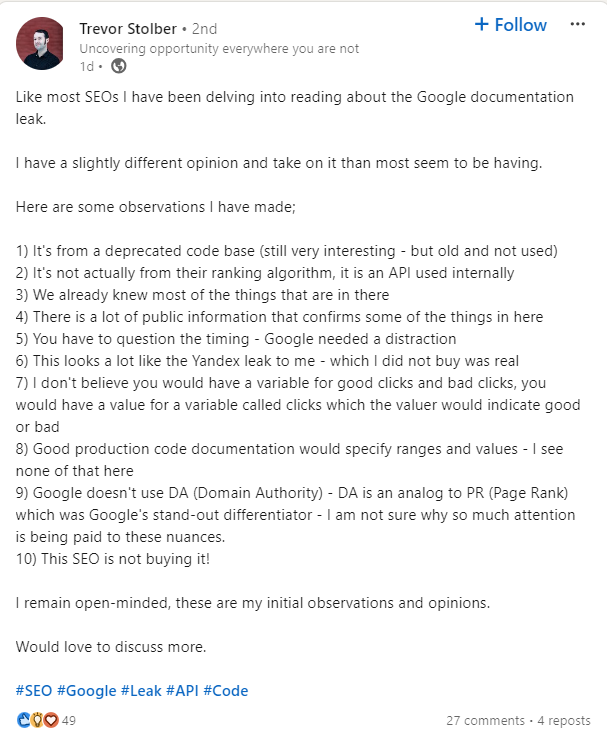
Credibility of Reporting Sources
The credibility of the news outlets and sources reporting on the Google search leak is significant. Reputable and established tech news websites, cybersecurity firms, or industry analysts typically provide reliable information. These sources have a track record of accuracy and are less likely to report unverified or sensationalized information.
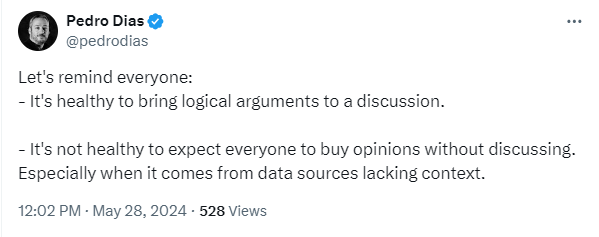
Google’s Response
Google’s official response, or lack thereof, can be telling. If Google acknowledges the documents and provides a statement, it can help validate the leak’s authenticity. On the other hand, a strong denial or legal action from Google might indicate the documents are real, though it could also be a protective measure against misinformation. Observing how Google addresses the leak in public forums, press releases, or legal actions can offer insights into the validity of the information.
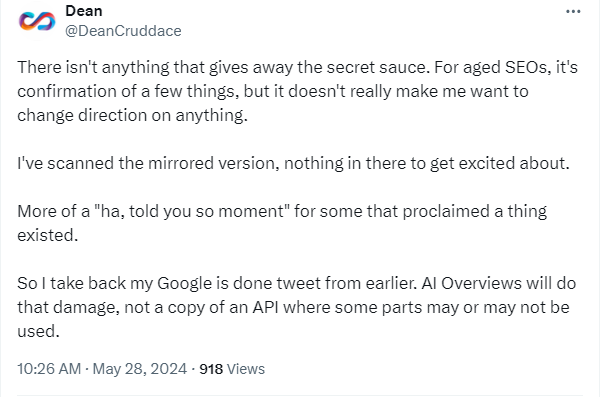
Assessing Trust
While the purported leak provides detailed and valuable insights, several steps must be taken to establish its trustworthiness:
- Cross-reference the information: Verify the data within the documents by comparing it with known facts and previously confirmed information. Look for consistency with Google’s past communications and publicly available data.
- Evaluate source credibility: Consider the reputation of the outlets reporting on the Google search leak. Trusted tech news websites, established cybersecurity firms and well-regarded industry analysts are more likely to provide accurate information.
- Monitor Google’s response: Pay attention to Google’s official response. Acknowledgment of the documents can lend credibility, while legal action might also indicate the documents’ authenticity.
- Seek expert opinions: Consult industry experts for their analyses and opinions. Professionals with deep knowledge of Google’s operations and SEO practices can provide valuable insights into the legitimacy of the leaked information.

Should SEO Strategists and Content Marketing Managers Be Concerned About The Google Search Leak?
SEO strategists and content marketing managers should be concerned about the purported leak because it presents both opportunities and challenges.
Key Concerns
- Changes in SEO best practices: The leak could reveal changes in Google’s ranking algorithms and best practices that are not publicly disclosed. This might necessitate a reevaluation and adjustment of current SEO strategies to align with newly discovered factors.
- Increased competition: With detailed insights into Google’s internal operations, more businesses might implement advanced SEO techniques, increasing competition for top search rankings. This means SEO strategists need to be more innovative and vigilant in their approaches.
- Ethical and legal implications: Using leaked information, especially if it includes proprietary or confidential data, could raise ethical and legal issues. SEO professionals must balance the potential benefits of applying these insights with the ethical considerations of utilizing possibly illicitly obtained information.
- Evolving compliance requirements: The leak might highlight stricter compliance and content quality requirements that Google is prioritizing. SEO strategists and content managers must ensure their practices and content meet these enhanced standards to avoid penalties.
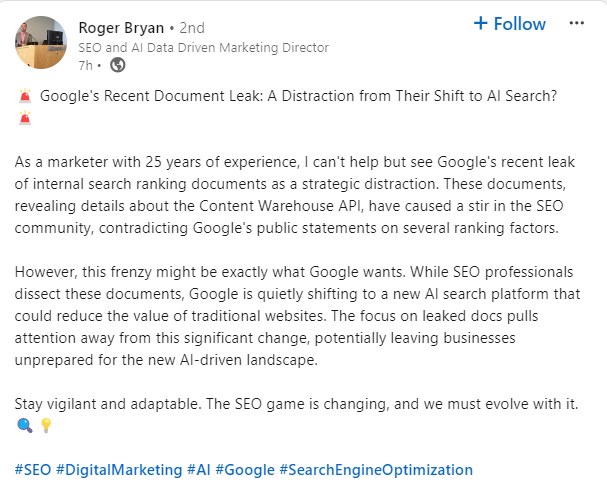
Some Myths Surrounding the Google Search Leak
Several myths have emerged regarding the Google search leak, and it’s important to address these to avoid misconceptions:
Myth 1: The Leak Proves Google’s Algorithms are Entirely Manipulative
Some believe the leak shows Google’s algorithms are designed to manipulate search results for commercial gain. However, the documents primarily reveal efforts to enhance user experience and combat spam.
Myth 2: Using Information from the Leak is Unethical
While using leaked information can raise ethical concerns, much of the content aligns with existing public knowledge about SEO best practices. Ethical SEO focuses on transparency and quality.
Myth 3: The Google Search Leak Will Lead to Major Algorithm Overhauls
There is speculation that Google will overhaul its algorithms due to the leak. However, Google continually updates its algorithms, and the leak is unlikely to prompt drastic, immediate changes.
Myth 4: SEO Practices Must be Completely Revamped
Some believe all current SEO strategies need an overhaul in light of the leak. In reality, the fundamentals of SEO remain consistent, emphasizing high-quality, user-focused content.
Myth 5: The Google Search Leak Provides a “Magic Formula” for SEO Success
There’s a misconception that the Google search leak reveals a secret formula for guaranteed high rankings. Effective SEO still requires ongoing effort, adaptation, and adherence to best practices.
Opportunities for Improvement
- Enhanced understanding of algorithms: The documents offer deeper insights into Google’s algorithms, helping SEO professionals fine-tune their strategies. Understanding specific ranking signals or penalties can lead to more effective optimization.
- Improved content quality: Knowing more about what Google values in terms of content quality (e.g., the importance of E-A-T) allows content marketing managers to produce higher-quality, authoritative content that aligns with Google’s guidelines, thereby improving search visibility and user trust.
- Advanced SEO techniques: The leak could introduce advanced SEO techniques and methodologies previously unknown or misunderstood. This can lead to the adoption of more sophisticated strategies, enhancing the overall effectiveness of SEO efforts.
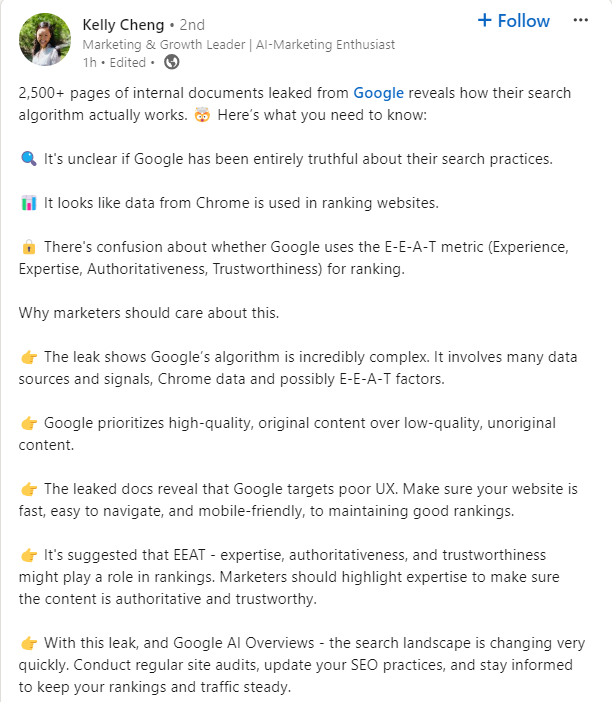
What Can SEO Strategists and Content Marketing Managers Learn From the Google Search Leak?
The Google search leak provides SEO strategists and content marketing managers with valuable insights and reminders about optimizing their strategies. Here are key takeaways and actionable lessons from the leak:
1. Focus on User Intent
Lesson: Understanding and aligning with user intent is critical. Google’s algorithms prioritize delivering results that best match what users are searching for beyond mere keyword matching.
💡 Action items:
- Conduct thorough keyword research to understand the intent behind searches.
- Create content that directly addresses the needs, questions, and problems of your target audience.
- Use tools like Google Analytics and Search Console to analyze user behavior and adjust content strategies accordingly.
2. Emphasize E-A-T
Lesson: Google values content from credible sources. The E-A-T framework is a significant ranking factor, especially for YMYL (Your Money or Your Life) content.
💡 Action items:
- Ensure that your content is written or reviewed by subject matter experts.
- Build author profiles showcasing their credentials and expertise.
- Include citations from reputable sources and get mentions or backlinks from authoritative sites.
3. Maintain High-Quality Content Standards
Lesson: Quality content that is comprehensive, well-researched, and engaging is consistently rewarded by Google’s algorithms.
💡 Action items:
- Create in-depth, well-structured content that thoroughly covers topics.
- Use a mix of text, images, videos, and infographics to enhance user engagement.
- Regularly update and refresh older content to keep it relevant and accurate.
4. Maintain Ethical SEO Practices
Lesson: Avoid manipulative SEO techniques. Google’s documentation reveals that the search engine takes manual actions and uses algorithmic penalties against practices like cloaking, keyword stuffing, and link schemes.
💡 Action items:
- Focus on creating value-driven content instead of relying on black-hat SEO tactics.
- Ensure transparency and authenticity in your SEO practices.
- Monitor your site for any issues that might lead to penalties and address them promptly.
5. Leverage Personalization Insights
Lesson: Google personalizes search results based on user data. While this enhances relevance, it also underscores the importance of understanding your audience.
💡 Action items:
- Utilize user data to create personalized content experiences.
- Segment your audience and tailor content to different user groups.
- Respect user privacy and be transparent about data usage practices.
6. Understand the Ad and Organic Search Relationship
Lesson: While Google maintains a formal separation between paid ads and organic search, effective ad campaigns can indirectly benefit organic rankings through increased site traffic and engagement.
💡 Action items:
- Run targeted ad campaigns to boost initial traffic and engagement.
- Optimize landing pages to convert paid traffic into loyal visitors and improve overall site metrics.
- Monitor the impact of ad campaigns on organic search performance using analytics tools.
Ensuring Compliance with Google’s Guidelines
To stay compliant with Google’s guidelines, businesses should implement the following practices:
Regular Audits
- Conduct Regular SEO Audits: Perform comprehensive SEO audits periodically to ensure your practices align with the latest guidelines. This involves analyzing your website’s technical aspects, content, and backlinks.
- Tools: Utilize tools like Google Search Console, Ahrefs, SEMrush, and Screaming Frog to identify and resolve issues such as broken links, duplicate content, and crawl errors.
💡 Action item: Schedule quarterly audits to keep your site in compliance and optimize performance continuously.
Stay Updated
- Follow Official Google Sources: Follow official Google blogs, forums, and announcements to stay informed about any changes or updates to Google’s guidelines.
- Resources: Subscribe to the Google Webmaster Central Blog, Google Search Central, and relevant industry newsletters.
💡 Action item: Join SEO communities and forums such as the Google Search Central Help Community and Reddit’s SEO subreddit to stay informed about the latest trends and updates.
Ethical Practices
- Avoid manipulative SEO techniques: Avoid black-hat SEO tactics such as keyword stuffing, cloaking, and link schemes, which can lead to penalties.
- Transparency and authenticity: Ensure all your SEO practices are transparent and authentic. Clearly communicate your methods and intentions to both users and search engines.
- Focus on quality content and user experience: Prioritize creating high-quality content and delivering an excellent user experience.
💡 Action items:
- Focus on creating value-driven content that genuinely helps users and meets their search intent.
- Develop a clear content strategy that emphasizes quality, relevance, and user engagement.
- Update and improve your content regularly to keep it fresh and relevant. Enhance site usability and design to provide a seamless user experience.
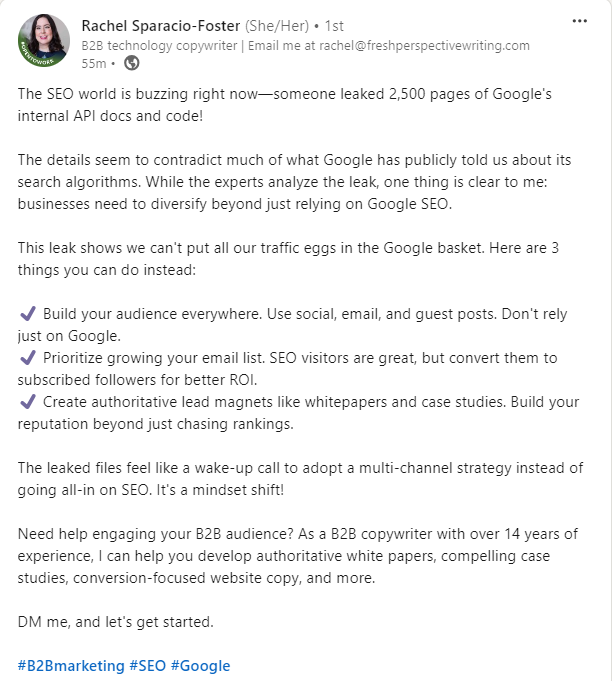
Best Practices for Ethical SEO
Maintaining ethical SEO practices is crucial for long-term success and avoiding penalties. Here are the key principles and actionable steps to ensure ethical SEO:
Transparency
Communicate clearly: Be transparent about your SEO methods and intentions with both users and search engines. Ensure your practices are easily understandable and justifiable.
💡 Action items:
- Your website should include a detailed privacy policy and terms of service. These should clearly state how user data is collected and used.
- Use structured data markup to help search engines understand your content better and provide users with accurate information.
Quality Content
Focus on value: Create high-quality, valuable content that genuinely meets user needs and search intent. Ensure your content is informative, engaging, and well-researched.
💡 Action items:
- Conduct thorough keyword research to understand what your audience is searching for. Use tools like Google Keyword Planner, Ahrefs, and SEMrush to identify relevant keywords and topics.
- Regularly update your content to keep it fresh and relevant. Incorporate multimedia elements such as images, videos, and infographics to enhance user engagement.
Avoid Manipulation
Steer clear of black-hat techniques: Avoid unethical practices such as keyword stuffing, cloaking, and link schemes, which can lead to penalties and damage your site’s reputation.
💡 Action items:
- Focus on organic link-building strategies. Earn backlinks through high-quality content, guest posting, and building relationships with industry influencers.
- Ensure your website’s content and structure are transparent and accessible to both users and search engines. Avoid using deceptive practices to manipulate rankings.
Role of UX and Site Performance
User experience (UX) and site performance are critical factors in SEO. Ensuring your website provides a fast, seamless, and engaging experience can significantly improve your search rankings and user satisfaction. Here’s how to optimize these elements:
Fast Load Times
Importance: Fast-loading websites provide a better user experience and are favored by search engines. Slow load times can lead to higher bounce rates and lower rankings.
💡 Action items:
- Use Google PageSpeed insights: Regularly analyze your site’s performance using tools like Google PageSpeed Insights, GTmetrix, or Pingdom. Identify areas that need improvement.
- Optimize images and media: Compress images and optimize media files to reduce load times. Use modern formats like WebP for images.
- Minimize HTTP requests: Combine files, use CSS sprites, and minimize the use of plugins to reduce the number of HTTP requests.
- Enable browser caching: Configure your server to enable browser caching. This allows frequently accessed files to be stored locally on users’ devices.
Mobile Optimization
Importance: With the majority of searches conducted on mobile devices, having a mobile-friendly site is essential. Google uses mobile-first indexing, meaning it primarily uses the mobile version of your site for ranking and indexing.
💡 Action items:
- Responsive design: Implement responsive web design to ensure your site adjusts smoothly to different screen sizes and devices.
- Optimize for touch: Ensure buttons and interactive elements are easy to tap on mobile devices. Avoid using pop-ups or interstitials that can disrupt the mobile experience.
- Test mobile usability: Use tools like Google’s Mobile-Friendly Test and Lighthouse to evaluate your site’s mobile usability and make necessary improvements.
Engaging UX
Importance: An intuitive, user-friendly interface keeps visitors engaged, reduces bounce rates, and encourages longer site visits, all of which can positively impact SEO.
💡 Action items:
- Clear navigation: Design a simple, intuitive navigation structure that makes it easy for users to find what they’re looking for. Use clear headings and logical menu structures.
- Consistent design: To create a cohesive and professional appearance, maintain a consistent design and layout across your site. Ensure that fonts, colors, and styles are uniform.
- Interactive elements: To engage users, incorporate interactive elements such as forms, buttons, and calls to action. Make sure these elements are easily accessible and functional on all devices.
- Content readability: Ensure that your content is easy to read with appropriate font sizes, line spacing, and contrast. Break up text with headings, bullet points, and visuals to improve readability.
The Path Forward: Implementing Ethical SEO Practices
The Google Search leak of 2,500 pages of internal Google documentation provides SEO strategists and content marketing managers with unprecedented insights into Google’s search operations. By understanding and applying these insights, professionals can optimize their strategies to align with Google’s best practices, improve content quality, and maintain ethical standards. However, it is essential to balance the benefits of these insights with ethical considerations and respect for user privacy.
